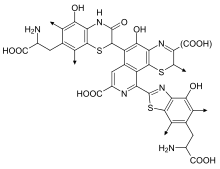Pheomelanin


The pheomelanin is a pigment which, together with a second type of pigment, the eumelanin , determines the skin color and, in mammals, including humans, the hair color or coat color . These pigments are also called melanins . Human melanin is a mixed type: pheomelanin dominates in red hair, while the second melanin type, eumelanin, as a brown-black pigment, is responsible for brown and black hair. Gray hair occurs when melanin production decreases with age. The melanin is then increasingly replaced by the accumulation of air bubbles in the hair shaft. The hair then appears gray to white, for example on the silverback . The genetic make-up for redhead is recessive and relatively rare in humans. In humans, eumelanin and pheomelanin usually occur together in different proportions.
The word component Phäo- is derived from the Greek φαιός phaiós : "dark".
biosynthesis
Tyrosine is biosynthetically converted in the first step with tyrosinase to DOPA and then to Dopaquinone . This is converted into cysteinyldopa with cysteine . Subsequent oxidation and polymerization leads to pheomelanin. If the biochemical conversion step from dopaquinone to 5,6-indolquinone cannot take place due to a genetic lack of an enzyme, for example because of the homozygous presence of the allele e on the extension locus , then only pheomelanin is formed from the dopaquinone.
Web links
Individual evidence
- ↑ James J. Nordlund, Raymond E. Boissy, Vincent J. Hearing, William Oetting, Richard A. King, Jean-Paul Ortonne: The pigmentary system: physiology and pathophysiology. Wiley-Blackwell, 2006, ISBN 1-4051-2034-7 .
- ↑ Pascal Kintz: Drug testing in hair. CRC Press, 1996, ISBN 0-8493-8112-6 , p. 74.
